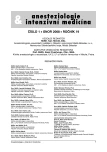Polyneuropathy and myopathy of critically ill patients – what’s new?
Authors:
J. Maňák
Authors‘ workplace:
Interní JIP, Klinika gerontologická a metabolická Fakultní nemocnice Hradec Králové
Published in:
Anest. intenziv. Med., 19, 2008, č. 1, s. 37-39
Category:
Intensive Medicine
Overview
This review summarizes important experimental and clinical studies published in the field of neuromuscular abnormalities of the critically ill during the last two years. Experimental work is focused mostly on the loss of membrane excitability using different animal models. Clinical studies emphasize that neuromuscular abnormalities occur early in the course of critical illness representing probably a part of the multiple organ dysfunction syndrome. The possible role of intensive insulin therapy in the pathogenesis of critical illness polyneuropathy and myopathy is discussed. Tight glycaemic control seems to be the only preventive measure which could lower the incidence of these complications.
Keywords:
critical illness weakness – critical illness myopathy – critical illness polyneuropathy – tight glycaemic control
Sources
1. Rich, M. M., Pinter, M. J., Kraner, S. D., Barchi, R. L. Loss of electrical excitability in an animal model of acute quadriplegic myopathy. Ann. Neurol., 1998, 43, p. 171–179.
2. Rossignol, B., Gueret, G., Pennec, J. P., Morel, J., Giroux-Metges, M. A., Talarmin, H., Arvieux, C. C. Effects of chronic sepsis on the voltage-gated sodium channel in isolated rat muscle fibers. Crit. Care Med., 2007, 35, 2, p.351–357.
3. Teener, J. W., Rich, M. M. Dysregulation of sodium channel gating in critical illness myopathy. J. Muscle Res. Cell Motil., 2006, 27, 5–7, p. 291–296.
4. Cankayali, I., Dogan, Y. H., Solak, I., Demirag, K., Eris, O., Demirgoren, S., Moral, A. R. Neuromuscular deterioration in the early stage of sepsis in rats. Crit. Care, 2007, 11, 1, p. R 1.
5. Norman, H., Kandala, K., Kolluri, R. et al. A porcine model of acute quadriplegic myopathy: a feasibility study. Acta Anaesthesiol. Scand., 2006, 50, 9, p. 1058–1067.
6. Mozaffar, T., Haddad, F., Zeng, M., Zhang, L. Y., Adams, G. R., Baldwin, K. M. Molecular and cellular defects of skeletal muscle in an animal model of acute quadriplegic myopathy. Muscle Nerve, 2007, 35, 1, p. 55–65.
7. Maňák, J., Schreiber, M., Matulová, H. et al. Early signs of critical illness polyneuropathy in porcine sepsis. Crit. Care, 2003, 7, Suppl. 2, p. S43.
8. Khan, J., Harrison, T. B., Rich, M. M., Moss, M. Early development of critical illness myopathy and neuropathy in patients with severe sepsis. Neurology, 2006, 24, 67, 8, p. 1421–1425.
9. Allen, D. C., Arunachalam, R., Mills, K. R. Critical illness myopathy: Further evidence from muscle-fiber excitability studies of an acquired channelopathy. Muscle Nerve, 2007, Aug.
10. Z’Graggen, W. J., Lin, C. S., Howard, R. S., Beale, R. J., Bostock, H. Nerve excitability changes in critical illness polyneuropathy. Brain, 2006, 129, 9, p. 2461–2470 .
11. Latronico, N., Bertolini, G., Guarneri, B. et al. Simplified electrophysiological evaluation of peripheral nerves in critically ill patients: the Italian multi-centre CRIMYNE study. Crit. Care, 2007, 11, 1, p. R11.
12. Hermans, G., Wilmer, A., Meersseman, W. et al. Impact of intensive insulin therapy on neuromuscular complications and ventilator dependency in the medical intensive care unit. Am. J. Respir. Crit. Care Med., 2007, 175, 5, p. 480–489.
Labels
Anaesthesiology, Resuscitation and Inten Intensive Care MedicineArticle was published in
Anaesthesiology and Intensive Care Medicine

2008 Issue 1
Most read in this issue
- The management of severe acute pancreatitis – state of the art
- Polyneuropathy and myopathy of critically ill patients – what’s new?
- Current treatment of sepsis in children
- Blood purification and acute renal failure: the timing, method selection and dosing of renal replacement therapy
